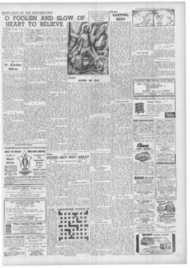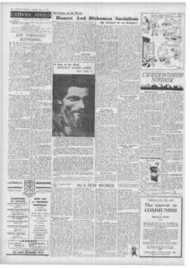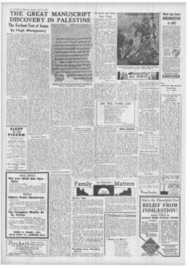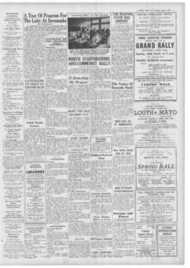Page 5, 14th April 1949
Page 5

Report an error
Noticed an error on this page?If you've noticed an error in this article please click here to report it.
Tags
Share
Related articles
Controversial Birth Of A Diocese
'establishment' Architects
Lancaster : The Youngest Diocese Celebrates Its Silver...
Child Of Last War
Architects From Without Church Americans' Irish View Of...
KNOW YOUR CATHOLIC ENGLAND
The Diose Of Brentwood—Leigh-on-Sea
This Parish Priest His Own Architect And Builder
By F. A. FLILFORD
Established in 1917, Brentwood is the youngest diocese but one in England. The youngest is Lancaster. Both have the distinction of honouring Our Lady of Lourdes as chief patron, and therein—where Brentwood is concerned—lies a story.
It all began with Brentwood's first Bishop, Bernard Nicholas Ward (brilliant writer, historian, scion of an illustrious Oxford Movement family), having a fervent devotion to Lourdes. While teaching at Old Hall, Herts, he t -used to persuade all his students to ; go to Lourdes for their summer holidays.
But he did not win over the student who is now Fr. Francis Walter Gilbert.
But to-day Fr. Gilbert is the parish priest of the church of Our Lady of Lourdes, Leigh-on-Sea, Essex, which he built relying on a promise made to him by Bishop Ward when he became first Bishop of Brentwood, a promise which, incidentally, the Bishop did not keep —not in this life anyway. And the promise, says Fr. Gilbert, was to help him build the church.
Bishop Ward died in his sleep barely three years after his consecration, Fr. Gilbert had a breakdown—and then went to Lourdes
much against his will, Someone bought him a ticket, and he couldn't refuse.
Had Bishop Ward lived, I would have found many other Lourdes churches in this one-county Diocese of Essex with its tiny cathedral at Brentwood; the Bishop got Canon Booker. who built the large church at Wanstead, to use Lourdes as dedication as well, and the emphasis on Our Lady is a pleasing feature in church titles everywhere in Essex to-day.
" A MIRACLE CHURCH" But the best memorial to Bishop Ward's remarkable love for Lourdes is undoubtedly Fr. Gilbert's own loveliest of stone Saxon churches at Leigh, "a miracle church," as Cardinal Bourne called it. It has, for Lady Chapel. a perfect replica of the Lourdes Grotto, even a piece of rock from the shrine is embedded in the construction.
The weather-vane on the tower, where hangs bells playing the Ave Maria chimes hourly, is a 2 ft, 10 in. copper plaque of Our Lady with a kneeling Bernadette, given by a convert Jew.
" I'll dedicate the diocese to Lourdes, and you'll dedicate Leigh church to Lourdes as well," said Bishop Ward to Fr. Gilbert, " help you."
The Bishop's sudden death, Fr. Gilbert's ensuing breakdown and a pilgrimage unwillingly undertaken to Lourdes, where he remarkably recovered, were followed by a determination to start building at once. " I now knew the Bishop would help me even in death," says Fr. Gilbert. His own architect and builder, Fr. Gilbert delved into his own pocket for much of the money, collected materials and stone, having the foundation stone laid on Rosary Day, October 7, 1924.
Consecration followed on Our Lady's Birthday. September 8. 1929 —centenary of Catholic Emancipation — the Lady " Grotto " Chapel, which is undoubtedly the church's unique feature, being itself consecrated on Lourdes Day, 1949, by Bishop Beck.
THE BELL
Now here's a curious anecdote Fr Gilbert tells. It was Armistice Eve, 1918, and there was only a temporary church at Leigh. A bell rang out joyfully in the neighbourhood during the night, people listened wondering if the war was really over. policemen went the round of the streets puzzled as they remembered the temporary Catholic church had no bell.
Nearing the spot where the ringing seemed to come from, they found it at once ceased.
Then it started again as the police moved off. Next morning Fr. Gilbert found a bell near the church, and with it a piece of paper he still treasures. It read: "This Is a thing of joy to all mankind. It conies front a sorrowful country. So, Father, ring it to God."
The story, when he eventually pieced it together. was that men of the second battalion, Leinster Regiment. quartered nearby, had carried the bell round with them as a trophy for two years. It had been a gas alarm from the trenches of France, and the enemy used to ring it every time our men went over the top. One night a group of the Leinsters, mostly Catholics, volunteered to get the bell. They did.
On Armistice Eve they rang it for sheer devilry, then presented it in the way described to Fr. Gilbert, who now uses it as a warning bell for Mass. First publication of the story in the press of those days brought him a gift of il.000 for his new church.
" OUR LADY OF CANVEY"
And here's another story: the Chink's at Leigh were, despite violent local opposition and threats of official action, put up on December 8, 1936, Feast of the Immaculate Conception. on the very day Parliament repealed the anti-Catholic laws forbidding bells.
Ending as I started, may I add yet another Marian note to the story of Leigh?
There is a wrought-iron basket on the beacon erected on the sea-wall on Canvey Island nearby, and the rivermen call it the " Old Lady of Canvey." Yet, says Fr. Gilbert, nautical charts and sailing directions refer to the beacon as " Our Lady of Canvey," so when he built a second church on the island he wished to dedicate it to " Our Lady ofTChael;eveYW'
were doubts, however, in other quarters regarding the historical genuineness of the dedication, so the church at Canvey now bears that title plus the further one of "The English Martyrs."
As King Alfred erected the seawall, it is possible, thinks Fr. Gilbert, that he also built the beacon there.
blog comments powered by Disqus









